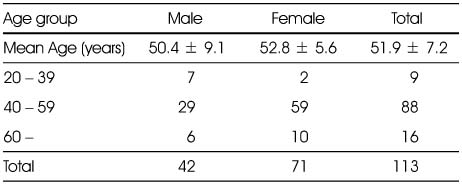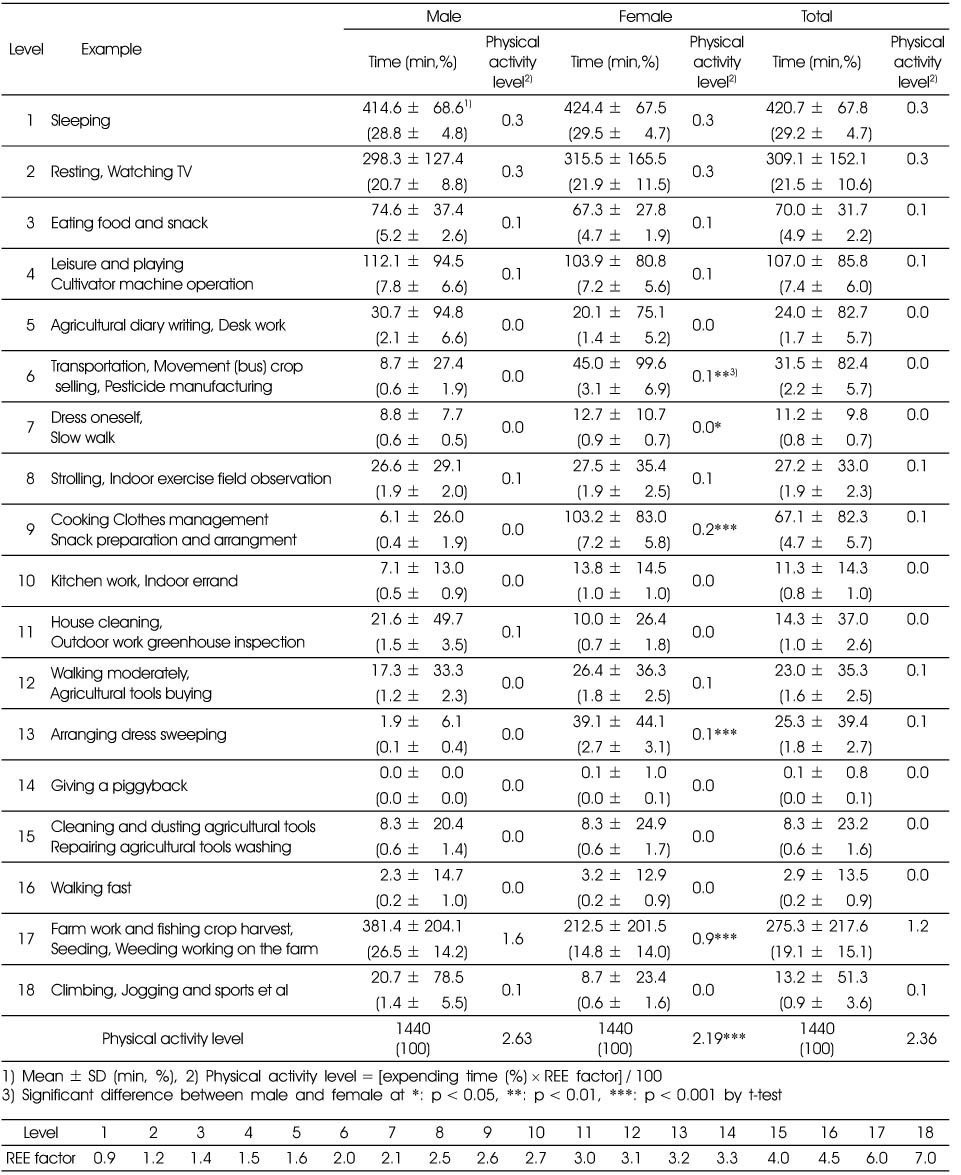References
1. Black AE, Coward WA, Cole TJ, Prentice AM. Human energy expenditure in affluent societies: an analysis of 574 doubly-labeled water measurements. Eur J Clin Nutr 1996. 5072–92.
2. Bleiberg FM, Brun TA, Goihman S. Duration of activities and energy expenditure of female farmers in dry and rainy seasons in Upper Volta. Br J Nutr 1980. 4371–82.
3. Choi HJ, Song JM, Kim EK. Assessment of daily steps, activity coeffcient, body composition, resting energy expenditure and daily energy expenditure in female university students. J Korean Diet Assoc 2005. 11(2)159–169.
4. Choi HS, Moon HK, Kim HY, Choi JS. Evaluation of the health status dietary intakes of the elderly in rural areas by dental status. J Korean Diet Assoc 2010. 16(1)22–38.
5. Choi JH, Hwang KS. The adaptability of Korean farmers to environment by the seasonal fluctuation of energy expenditure, cold and heat tolerance. Korean J Community Living Sci 2006. 17(2)49–60.
6. Choi JW, Chung ST, Seol H. Study on farm work environment load in Korea. Korean J Community Living Sci 1998. 9(2)43–50.
7. Choi JW, Oak SA, Kyoung SH. Study on farm work environment and physical load Korea. Korean J Community Living Sci 1999. 10(2)85–100.
8. Choi YE, Lee SL, Cho EH, Ria-Ann L, Kwak EH, Kim YH, Kwun IS. Comparison of nutrient intakes of Korean elder people living in rural area between 24-hour recall and food frequency method. J Korean Soc Food Sci Nutr 2006. 35(6)698–707.
9. Frankenfield DC, Eric RM, William AR. The Harris-Benedict studies of human basal metabolism: History and limitations. J Am Diet Assoc 1998. 98439–445.
10. Du Bois D, Du Bois EF. A formula to estimate the approximate surface area if height and weight be known. Arch Int Med 1916. 17863–871.
11. Dunn AL, Andersen RE, Jakicic JM. Lifestyle physical activity interventions: history, shor-term and long-term effects, and recommendations. Am J Prev Med 1998. 15398–412.
12. Durnin JVGA, Drummond S, Satynarayana K. A collaborative EEC study on seasonality and marginal nutrition: The Glasgow Hyderabad (S. India) Study. Eur J Clin Nutr 1990. 4419–29.
13. FAO/WHO/UNU. Energy and protein requirements. Report of a Joint FAO/WHO/UNU Expert Consultation. WHO Technical Report Series No 724 1985. Geneva: WHO;
14. Heymsfield SB, McManus C, Smith J, Stevens V, Nixon DW. Anthropometric measurement of muscle mass, revised equations for calculating bone-free arm muscle area. Am J Clin Nutr 1982. 36680–690.
15. Jung HS, Kim JK, Cho HC. A pilot study on examination for difference in physical characteristics, lifestyle factors and physical fitness between urban and rural old adults. Korean J Sports Sci 2010. 19(1)837–849.
16. Finan K, Enette L, Michael IG. Cross-validation of prediction equations for resting energy expenditure in young, healthy children. J Am Diet Assoc 1997. 97140–145.
17. Kim DJ. Studies of basal metabolism and energy expenditure of Korean in daily life. Korean J Nutr 1971. 449–62.
18. Kim EK, Kim EK, Song JM, Choi HJ, Lee KH. Assessment of activity coefficient, resting energy expenditure and daily energy expenditure in elementary school children. J Korean Diet Assoc 2006. 12(1)44–54.
19. Kim EK, Kim GS, Park JS. Comparison of activity factor, predicted resting metabolic rate, and intakes of energy and nutrients between athletic and non-athletic high school students. J Korean Diet Assoc 2009. 15(1)52–68.
20. Kim HA, Kim HD, Nam KS. A study of serum lipids and the obesity of housewives in Mooan, Chonnam. Korean J Community Nutr 1997. 2(3)319–326.
21. Kim HK, Chung CJ. The mathematical modelling of the field performance machines. J Biosyst Eng 1996. 21(3)357–371.
22. Kim HN, Jun SG, Jung HR, Lee DS. The energy expenditure of female farmer. survey improvement nutrition of farming 1986. Seoul: Rural Development Administration; 133–151.
23. Kim HN, Lee DT, Rhie SG. The energy expenditure of female farmers in Kyunggki area. J Korean Soc Food Nutr 1989. 18(2)189–194.
24. Kim HY, Kim GH, Kim HR, Kim YS. Menu development and application for rural eldery of Gangwon and Chungnam area at agricultural off-season. Korean J Community Living Sci 2009. 20(3)423–435.
25. Kim JH, Kim EK. Assessment of physical activity, activity coefficient of preschool children and actual condition of daycare center outdoor play. Korean J Community Nutr 2009. 14(6)777–788.
26. Kim KR, Lee KS, Kim HC, Ko ES, Song EY. Health condition and musculoskeletal disorder(MSDs) in fruit-growers. Korean J Community Living Sci 2009. 20(1)5–17.
27. Kim YN, Na HJ. The estimation of daily energy expenditure of Korean adolescents. Korean J Community Nutr 2003. 8(3)270–279.
28. Korean Society for the Study of Obesity 2000.
29. Lee DH, Park WK. Retrospection on agricultural mechanization researches. J Biosyst Eng 1999. 24(5)453–462.
30. Lee HM, Kim EK. Assessment of daily steps, physical activity and activity coefficient of the elementary school children in rural area. Korean J Community Nutr 2007. 12(3)361–371.
31. Lee JS, Lee GH, Kim EK. Assessment of daily steps, activity coefficient and daily energy expenditures of dieticians in Youngdong-area. J Korean Diet Assoc 2006. 12(3)277–288.
32. Lee MS, Woo MK. A study on the factors influencing food consumption by food frequency questionnaire for the middle aged and elderly living Chonju area. Korean J Community Nutr 2001. 6(5)789–797.
33. Lee SH, Park JS, Kim EK. Assessment of daily steps, physical activities and activity coefficient of policemen who do shift-work. Korean J Nutr 2007. 40(6)576–583.
34. Lee SG, Jun SG, Gwan GH. Expenditure energy of farm work model. survey improvement nutrition of farming 1986. Seoul: Rural Development Administration; 255–291.
35. Lee SG, Kim HN. The Comparison of Energy Expenditure and Fatigue Degree by Use of Working Table. Korea J Rural Living Sci 1991. 243–49.
36. Lee SG, Kim HN, Lee DT. A study on Energy Consumption and Fatigue Reduction in Floral Work. Korea J Rural Living Sci 1992. 345–52.
37. Lim WJ, Yoon JS. A longitudinal study on seasonal variation of physicl activity and body composition of rural women. Korean J Nutr 1995. 28(9)893–903.
38. Lim WJ, Yoon JS. A study on health status, meal management, and seasonal variation of nutrient intake of rural women. J Korean Soc Food Sci Nutr 1997. 26(6)1215–1220.
39. Ministry of Health, Labour and Welfare. The fifth Japanese dietary allowance 1985.
40. Owen OE. Resting metabolic requirements of men and women. Mayo Clinic Proceedings 63 1988. 503–510.
41. Park JA, Kim KJ, Yoon JK. A comparison of energy intake and energy ex penditure in normal-weight and over-weight Korean adults. Korean J Community Nutr 2004. 9(3)285–291.
42. Park MY, Chun BY, Joo SJ, Jeong GB, Huh CH, Kim GR, Park PS. A comparison of food nutrient intake status of aged females in a rural long life community by the stage model of dietary behavior change. Korean J Community Nutr 2008. 13(1)34–45.
43. Park MY, Yoon HS. Nutrition status of rural elderly living in Kyungnam. Korean J Community Nutr 2001. 6Suppl. 527–541.
44. Rhie SG, Kim HN. The comparison of energy expenditure and fatigue degree by use of working table. Korean J Community Living Sci 1991. 243–49.
45. Rhie SG, Kim HN, Lee DT. A study on energy consumption and fatigue reduction in floral work. Korean J Community Living Sci 1992. 245–52.
46. Ryu AY. Study on the needs of the aged in the farm area for the integrated service of health care and welfare: Focused on Chilgok-gun in Kyungbuk province 2007. Keimyung University; MS Thesis.
47. Schultink WJ, Klaver W, VanWijk H, Van Raaij JMA, Hautvast JGAJ. Body weight changes and basal metabolic rates of rural beninese women during seasons with different energy intakes. Eur J Clin Nutr 1990. 4431–40.
48. Firouzbakhsh S, Richard KM, Wendy LD, Ronald SO, Paula KG, Kenneth EG, Jerry ZF. Measured resting energy expenditure in children. J Pediatr Gastroenterol Nutr 1993. 16136–142.
49. Statistics Korea. 2009 Socio-Statistical Survey 2009.
50. Statistics Korea. Time use survey 2009.
51. Stifelman M. Using doubly-labeled water measurements of human energy expenditure to estimate inhalation rates. Sci Total Environ 2007. 373585–590.
52. The Korean Nutrition Society. Dietary Reference Intakes for Koreans 2010. Seoul: Korean Nutrition Society;
53. Yoon GA. Relationship of weight status and physical activity of adolescents in Busan city. Korean J Nutr 2001. 34(1)39–47.
54. Yoon JS, Kim KJ, Kim JH, Park YS, Koo JO. A study to determine the recommended dietary allowance of energy and to develop practical dietary education program for Korean adults 2002. Keimyung University, Ministry of Health and Welfare;







